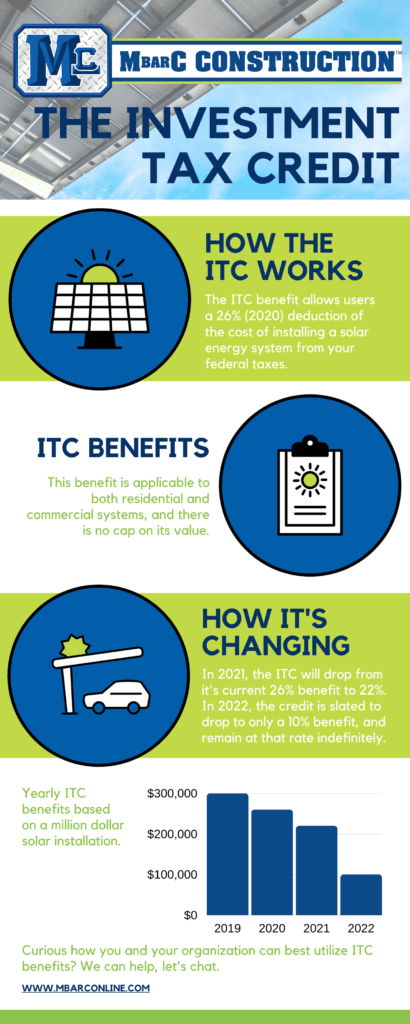ITC benefits provide organizations substantial cost savings to solar installations. In 2021 ITC benefits will shift; here’s what you need to know and how we can help.
 What is the Federal Investment Tax Credit?
What is the Federal Investment Tax Credit?
In 2005, Congress approved a sustainability-driven spending bill that revolutionized the renewable energy industry. This bill is known by most as the solar ITC. It was originally set to expire in 2007, but its success in expanding the industry and creating jobs proved so valuable that congress has extended it multiple times. On December 18, 2015, another extension was made that would continue to make solar energy more affordable for all Americans.
With clear signs of industry growth, congress came to the decision of extending the ITC an additional five years, scheduled to last until 2021. Compiled data from experts found that this five-year extension would “bring the solar industry to its full maturity.”
Despite this being the second extension, in the years following 2021, there will be a continued 10% tax credit for commercial installations. While the value of the credit is less than in previous years, this decreased percentage is still vital in supporting the growth of sustainable energy.
What is the solar tax credit exactly, and more importantly, how is it going to help you?
The solar tax credit initially encouraged Americans by providing access to a 30% tax break on their federal taxes from 2016 – 2019. This credit is based on the total PV system cost and can be used to directly offset federal tax liability on a dollar-for-dollar basis. Since then, there has been a deduction of 4% to the overall benefit percentage allowing a 26% deduction until the end of 2020.
Beginning in 2021, the ITC benefits will drop to 22%. As of today, the credit is planned to drop to 10% in 2022 and remain indefinitely. It will be up to the support of the renewable industry and advocates like the Solar Energy Industries Association to successfully lobby for another extension.
There’s good news, and there’s bad news; the good news is the benefits of the ITC apply to all solar owners; whether commercial or residential… for now. The bad news is that beginning in 2022 when the percentage drops to 10%, residential solar owners will not receive any benefits; only commercial owners will be eligible for the 10% credit. If you are unsure if solar is a good fit, you may want to consider the approaching deadlines. Often, good things are known to come to an end, and now is a better time than ever to invest in solar. Remember that there is no cap on its value, meaning that the larger the project, the greater the tax credit.
How the ITC has Boosted Solar
The Investment Tax Credit (ITC) is the strongest policy there is to support clean energy development. This policy encourages economic growth, intentionally creates jobs, and meaningfully cuts emissions. Since 2005, when the ITC was first passed, it has created hundreds of thousands of jobs. Additionally, the ITC benefits have sparked more than $140 Billion in private investments and helped grow solar deployment by more than 10,000%.
This program has been life-changing for not only the solar industry but for the overall sustainability of our nation.